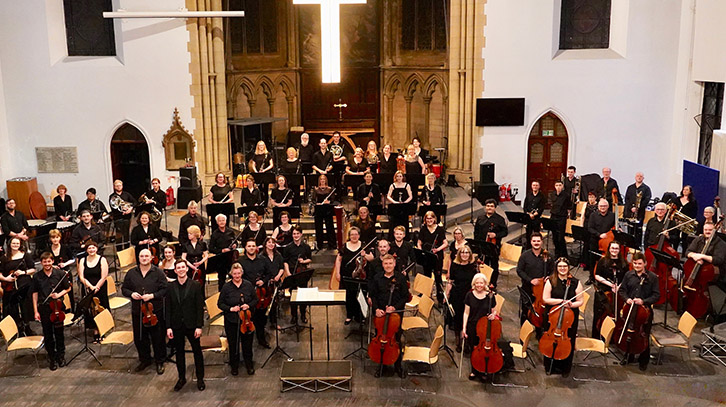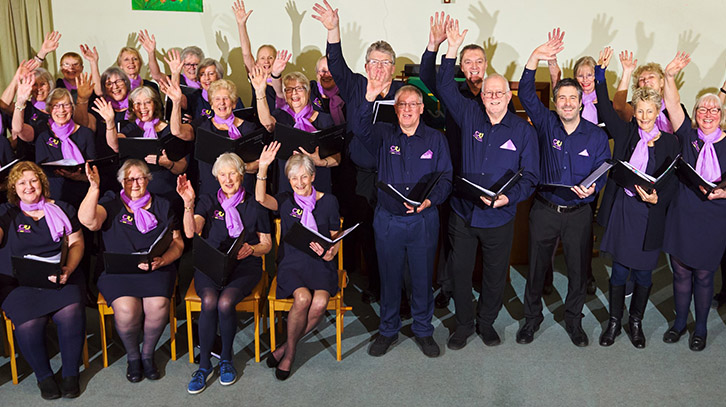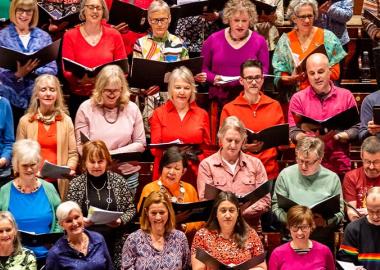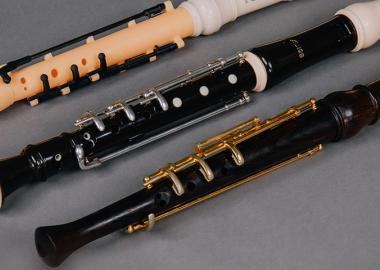What your music group chooses to wear on stage is part of how you present yourself to the world - but care must be taken not to have it become a barrier that might lead to exclusion.
A group's performance wear - their 'uniform' - is the first thing an audience will see, which is why many groups choose to specify what their members wear while performing. This can be a good thing; uniform can bring a sense of belonging to people and help them feel part of a team. If you’re trying to present a unified sound, it can also be effective if you look uniform too.
For some types of group, such as brass bands and barbershop groups, uniform is heavily rooted in tradition. Competing barbershop groups are judged on the visual and vocal aspects of their performance so may require a higher-level of uniformity than non-competing groups.
However, we know that having to wear a specific item or type of clothing can be a barrier to someone taking part in a group. This resource looks at some of these barriers and shows some things that music groups have done to address them.
What is a barrier?
A barrier is a reason why someone might find it difficult or impossible to take part in an activity you organise. It’s something that has stopped them from accessing and being included in your activities. It’s helpful to consider what barriers might be preventing people from joining or staying in your group as it gives you a practical way to address any issues. For more information about identifying and removing barriers, have a look at our Creating an accessible and inclusive group resource.
We know that there are some barriers that are specific to clothing; here are some things to consider.
Cost
Cost is a barrier to attending leisure-time activities in general, but this could be increased by having to buy an expensive uniform or costume.
Fit and wearability
Everyone’s body is different; if you have a specific item of clothing you require people to wear, it may not fit them properly or may restrict them when playing their instrument or singing. They may have medical equipment that prevents them wearing certain types of clothing. Some neurodiverse people find that specific fabrics or styles of clothing cause sensory challenges, which are distracting and prevent them performing to their best level. Some mental health conditions might cause people to feel anxious or distressed about wearing clothes over which they do not have control.
Cultural considerations
Some religions have particular dress codes or items of clothing that members wear to outwardly show their beliefs. This might make it difficult for them to wear a specific uniform or might mean they’re the only person that looks different. There are also types of clothing historically associated with certain social classes that may unconsciously make people feel excluded. This is also the case across generations; younger people tend to dress more casually so a more formal uniform may not appeal to them.
Gendered clothing
Requiring people to wear clothing based on their gender is a barrier to people who are non-binary or exploring their gender identity, as well as people who would rather not wear explicitly gendered clothing. A lot of unisex clothing is cut for a masculine frame so may not fit those with a feminine frame well.
We asked some Making Music member groups what they wear to perform in and what they’ve done to address certain barriers with their dress code while still looking 'uniform'.
Leeds Symphony Orchestra: 'all-black'
Leeds Symphony Orchestra’s dress code for concerts is 'all black'. This allows them to look smart and unified but enables members to choose what clothes they wear as long as they’re black.
Until a couple of years ago, for most concerts men would wear dinner jackets and women would wear black clothes, but the orchestra voted to change to everyone wearing all black, regardless of gender identity. Continuing to look smart as an orchestra was important to them, but most of the members decided it would feel more inclusive to stop distinguishing between men and women and have the same dress code for everyone. Some also found the dinner jackets uncomfortable to play in and the cost of buying or hiring one off-putting.
There was a bit of resistance to the change initially but holding a vote helped make it a democratic decision and gave the whole membership the chance to have their say.
Leeds Symphony Orchestra in 'all-black'
What barriers does this address?
- Fit and wearability: members can choose clothes that are comfortable for their instrument and their body.
- Gender: there are no requirements based on the gender of the performer.
- Cost: black is a common colour for clothes so can be found easily, bought fairly cheaply, or borrowed.
- Cultural: most religious or cultural clothing could be found in black to fit this dress code.
What makes this uniform?
All members wearing the same, neutral, colour means that no one stands out. Some groups also specify a sleeve length or skirt / trouser length to increase the uniformity of the group.
Black is a practical colour for this as there are fewer shades to choose from, helping achieve a uniform look. If you choose to use another colour, specifying a shade is a good idea. For example, 'navy blue' rather than just 'blue' or 'lime green' rather than 'green'.
OutSingCancer Choir: provided uniform
OutSingCancer Choir provide a uniform for their singers to wear which is:
- Women: navy blue tunic dresses with the choir logo, lilac chiffon scarves, and legs covered by navy tights or similar.
- Men: navy blue shirts with the choir logo, lilac handkerchiefs in their pocket and dark trousers.
They also provide warm waterproof coats for outdoor performances.
The choir is for people whose lives are affected by cancer. When it was founded, they decided they wanted everyone to look uniform without having to spend any money or placing extra stress on people whose lives already had a lot on. The choir fundraised to buy the uniforms so that members can be issued with a uniform when they join.
They chose a style of dress that would hang loosely so would be suitable for all shapes and not be restrictive. The dresses come in different sizes so members could request a different size if their body changes, or its needs change. They’re also easy to wash. Members are shown how to arrange the scarves and pocket squares so they look consistent. The colours match their brand colours of purple and gold and the choir feels like the uniform helps them look professional, building their confidence.
OutSingCancer Choir in navy blue and lilac
What barriers does this address?
- Cost: members do not have to buy their uniform.
- Cultural: uniforms act as a social leveller and allow the focus to be on the group, rather than individual differences.
- Time: members are given the uniform which means they don’t have to find time to go shopping for new clothes or deciding what would be appropriate to wear for a concert.
What makes this uniform?
A set uniform is a common way to ensure everyone looks the same on stage. Some groups take this further and have the same uniform regardless of gender.
A very common provided uniform is a t-shirt with a printed logo. This addresses the cost barrier but removes some of the other barriers that could come with set uniforms. If you take this option, make sure there are different sizes and cuts available (e.g. men’s cut and women’s cut).
Hillfoot Harmony: barbershop-inspired costumes
Hillfoot Harmony used to compete in barbershop competitions, where it was expected that all performers would wear the same costume. They’ve recently relaxed their costume requirements a bit, but still believe that you shouldn’t be able to pick out a particular person within the choir.
For a recent concert they wore black clothes (all with a similar neckline), a red shawl with loose sleeves, and matching sparkly earrings and necklaces.
The red shawls have belonged to the choir for a long time. They are light and loose, so they accommodate all body shapes and sizes, and do not add much weight to the performers.
For more casual events they’ll wear jeans and a white shirt, or black trousers and a black t-shirt with the choir logo on.
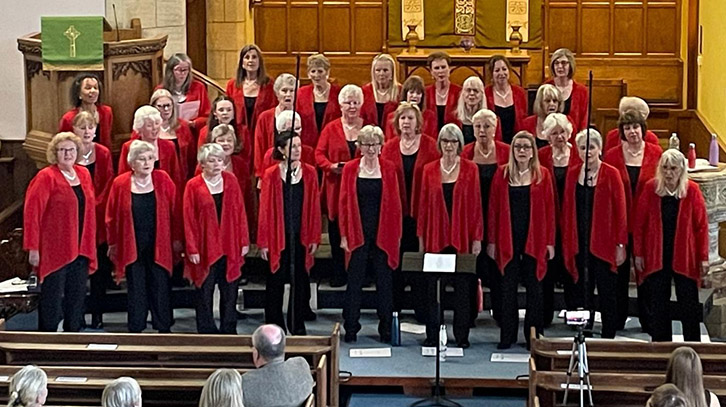
Hillfoot Harmony in black, red and sparkly jewellery
What barriers does this address?
- Fit and wearability: choir members choose which clothes they wear as a base, meaning they can be comfortable.
- Cost: the choir owns the red shawls and necklaces, so the choir-specific elements come at no cost to members.
- Cultural: the extra ‘costume’ elements could be worn on top of or alongside religious clothing.
- Gender: although Hillfoot Harmony are a ladies choir, this approach of a neutral base with a something colourful added on top could be used by any group, regardless of gender.
What makes this uniform?
A neutral base that then has uniform elements added on top allows members to choose most of the outfit, especially the parts that are next to their skin. In this example, specifying the shape of the neckline and the matching necklaces shows how small but eye-catching details can elevate the level of uniformity. Focus on the details that people will see and where you want their eyes to be drawn. Colourful scarves, ties, or rosettes would also serve the same purpose.
Astley Youth Band: flexible uniform
Astley Youth Band are a musical organisation that contains several different ensembles, including the Astley Youth Band (under 19s) and Astley Unlimited Band (players of any age).
Their uniforms are based on brass band traditions but with some flexibility as they want their performers to feel comfortable and confident on stage. Having some guidelines about uniform helps their members to feel part of the group but keeping it flexible means that members can wear clothes that are comfortable and convenient.
The Youth Band wears smart black trousers/skirts, long-sleeved white school shirts, black socks and shoes, along with a red waistcoat and black bow tie which are provided by the band. The Unlimited Band wear white shirts, black shoes and socks, and black jackets or cardigans. Men are also given a band tie. Women can wear smart white blouses or tops instead of a shirt if they prefer. They also wear band polo shirts as an informal uniform.

Youth Band in waistcoats and bow ties
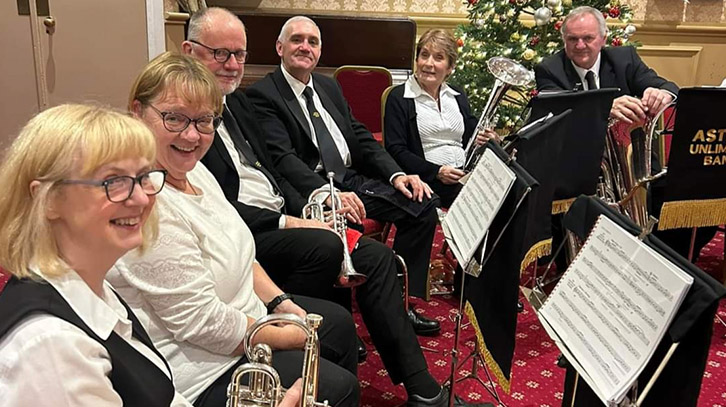
Unlimited Band in 'white-and-black'

Informal uniform of polo shirts
What barriers does this address?
- Cost: the band-specific items are provided. The other items are common and can be bought easily and fairly cheaply. For the Youth Band, the items are the same as a lot of school uniforms.
- Fit and wearability: they do not have specific 'band jackets' like many brass bands, instead they ask members to wear a black suit jacket or cardigan. This means members can wear jackets that fit them and are comfortable to play in, rather than borrowing a jacket that may not fit and be uncomfortable.
- Cultural: as with school uniforms, the uniform removes the opportunity to wear expensive branded clothing that can lead to biases.
- Gender: one of the uniform options is a polo shirt and either black trousers or skirt for everyone. The more formal option is gendered in that there are different options for men and women. The traditional brass band style jacket is not designed for womens’ bodies so they offer other options that may be more comfortable for playing.
What makes this uniform?
In their informal polo shirt uniform the band are clearly identifiable and everyone is wearing a very similar outfit. In the formal uniform for the Unlimited Band, despite not everyone wearing exactly the same outfit, having white shirts and black jackets/cardigans gives the illusion of uniformity.
They specify that shoes and trousers should be smart (i.e. not trainers or jeans), which allows people to wear what is comfortable for them but maintain a level of smartness.
So, what does this mean for your group?
If you haven’t thought about what your group wears for performances for a while you could take this opportunity to review it.
If you decide you want to change your performance wear, you should include your whole group in this discussion. You could gather opinions in several ways, from using surveys to having an open discussion. Ask your members: 'are there any barriers that would prevent you or someone you know from wearing this?' If anything comes up, work out the best way of making an adjustment together.
While you won’t be able find an approach that addresses every single barrier, consider what are the most likely barriers to members of your community, and choose an option that can be flexible.
With any change, there is the possibility that you might experience some resistance but consider why you are making the choice to have a specific dress code and communicate this clearly. It’s easier to bring members of your group along with you if they can understand the reasoning behind your choices.
As new members join your group you should always ask about adjustments they might need, including to your clothing requirements. Have a look at our Welcoming new people resource on how to do that.
We know there are lots of brilliant examples of concert dress out there and other ways of addressing barriers. If you have a good story about updating your performance wear or any thoughts and suggestions based on this resource, we would love to hear them. You can get in touch with us by email.
This resource was created as part of our INCLUDE programme, funded by Arts Council England from 2023-2025. Read more about Making Music: INCLUDE
We hope you find this Making Music resource useful. If you have any comments or suggestions about the guidance please contact us. Whilst every effort is made to ensure that the content of this guidance is accurate and up to date, Making Music do not warrant, nor accept any liability or responsibility for the completeness or accuracy of the content, or for any loss which may arise from reliance on the information contained in it.




